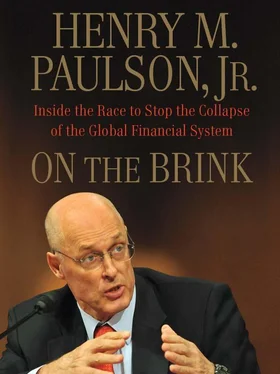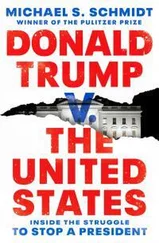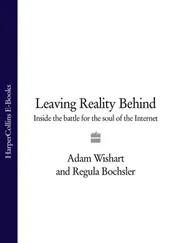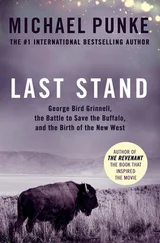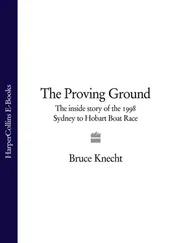An obvious issue is whether such a utility approach leaves room for the private sector in the secondary mortgage market. The size of the loans subject to the government-backed guarantee, as well as the price charged for the guarantee, would determine the extent of the private sector’s role. This should frame the debate and force policy makers to determine the government’s proper role in stimulating and subsidizing housing.
There is much other work to be done. Not only must we update our woefully inadequate regulatory architecture to better deal with large, interconnected financial institutions, we must also strengthen oversight of complex financial products, reform credit rating agencies, maintain fair-value accounting, change the way money market funds are structured and sold, and reinvigorate the securitization process. Underlying all of these actions is the need for greater transparency. Complexity is the enemy of transparency—whether in financial products, organizational structures, or business models. We need regulation and capital requirements that lead to greater simplicity, standardization, and consistency.
Contrary to popular belief, credit default swaps and other derivatives provide a useful function in making the capital markets more efficient and were not the cause of the crisis. But these financial instruments do introduce embedded and hidden leverage into financial institutions’ balance sheets, complicating due diligence for counterparties and making effective supervision more difficult. The resulting opacity, which should be unacceptable even in normal markets, only intensified and magnified the crisis. This system needs to be reformed so that these innovative instruments can play their important role as mitigators, not transmitters, of risk.
Standardized credit default swaps, which make up the vast majority of CDS contracts, should be traded on a public exchange, and nonstandardized contracts should be centrally cleared, subject to more regulatory scrutiny and greater capital charges. The key to this solution is for regulators to encourage standardization, require transparency, and penalize excessive complexity with capital charges. There will still be a role for customized derivative contracts, but only accompanied by appropriate supervision and increased costs.
One of the most glaring problems to emerge from the crisis was the poor quality of the rating of debt securities provided by the three major credit rating agencies: Moody’s, Standard & Poor’s, and Fitch. All have been granted special status as Nationally Recognized Statistical Ratings Organizations (NRSROs) by the SEC.
When I came to Washington in July 2006, only nine private-sector companies in the world carried a triple-A rating. Berkshire Hathaway and AIG were the only financial institutions so rated; GE, a major industrial company with what is essentially a large embedded financial institution, also had the top rating. Today there are only five triple-A-rated companies; AIG, Berkshire Hathaway, and GE have all been downgraded (as was Toyota). Yet as recently as January 2008, there were 64,000 structured financial instruments still rated triple-A, and many others had investment-grade ratings. As the credit crisis intensified, more than 221,000 rated tranches of asset-backed securities were downgraded in 2008 alone.
The agencies are enhancing the transparency, rigor, and independence of their ratings of structured products. But in the future, financial institutions and investors need to do more of their own homework, and regulators should no longer blindly use a high credit rating as a criterion for low capital requirements.
To reduce investor and regulator laxness resulting from overreliance on a few monopoly researchers, I would like to see a further review of how to increase competition among rating agencies. In addition, banking and securities laws and regulations should be amended to remove any reference to credit ratings as criteria to be relied on by regulators or investors to assess risk and capital charges.
Some people have also blamed the use of fair-value accounting for causing or accelerating the crisis. To the contrary, I am convinced that had we not had fair-value—or as it is sometimes known, mark-to-market—accounting, the excesses in our system would have been greater and the crisis would have been even more severe. Managements, investors, and regulators would have had even less understanding of the risks embedded in an institution’s balance sheet.
We need to maintain fair-value accounting, simplify the current implementation rules, and ensure consistency of application both globally and among similar institutions. The U.S. and international accounting standards setters must be allowed to get on with this important task without being pressured to make short-term, piecemeal changes that mask honest reporting by financial institutions.
It is critical to have an accounting system that shines a light on any securities with impaired value for which there is not an active market. These difficult-to-value assets need to be identified and their valuation methodology described in a clear and open manner.
There are more than 1,100 money market mutual funds in the U.S., with $3.8 trillion in assets and an estimated 30 million–plus individual customers. This is a concentrated yet fragmented industry with the top 40 funds managing about 30 percent of the assets. These funds invest for the most part in commercial paper instruments with a top credit rating or in government or quasi-government securities. Before the crisis, investors had come to believe that they would always have liquidity and would be able to get 100 percent of their principal back, because funds would always maintain a net asset value (NAV) of at least $1.00.
In the immediate aftermath of the Lehman failure, money market mutual funds came under intense pressure. A number were on the verge of “breaking the buck.” This dramatically eroded investor confidence, causing redemption requests to soar. In turn, the money funds pulled back on their funding of the many large financial institutions that depended on them for a big portion of their liquidity needs. It was a development that we were not well equipped to address.
We stepped in to guarantee the money market funds to prevent the crisis from getting worse, but the fundamental problems in the industry’s business model remain. Many of these funds charge investors very low fees, often as little as 5 basis points—or 0.05 percent—while offering interest rates that are higher than those available on insured bank deposits or on Treasury bills. If something looks too good to be true, it almost always is. In this case, it was the money fund industry’s soft or implicit guarantee of immediate liquidity and full return of principal with a premium yield and a low fee. Many, if not most, of these funds simply did not have the financial capacity to maintain their liquidity or a 100 percent preservation of capital for their investors in the midst of the credit crisis.
This expectation of complete liquidity with no fear of loss is a problem that should be addressed. Money funds are investment products, not guaranteed accounts. For years, the SEC has tried, unsuccessfully, to address this misperception. The SEC should explore whether fund managers should move from a fixed NAV, which makes money market funds resemble insured bank accounts, to a floating NAV. The funds would still be great products and could offer attractive returns, liquidity, and very low volatility and principal risk. But, as clients saw slight variations in principal, they would have a tangible indication that they were not investing in a bank account.
The credit crisis also exposed the erosion in mortgage underwriting standards, particularly in the originate-to-distribute securitization chain. To strengthen the underwriting practices and better align the interests of all parties, sponsors of these securities should be required to keep a continuing direct economic stake in the mortgages so that they have some “skin in the game,” with exposure to any future credit losses.
Читать дальше
